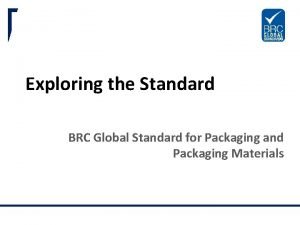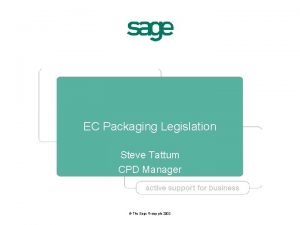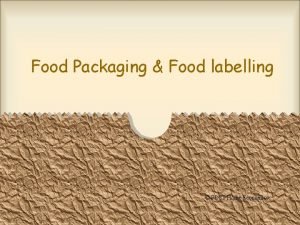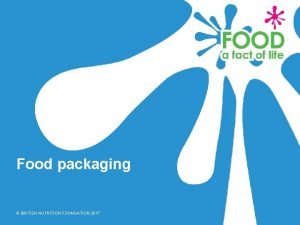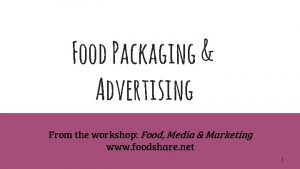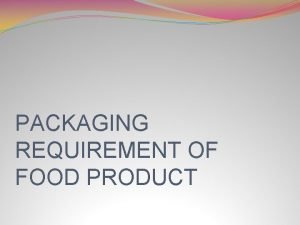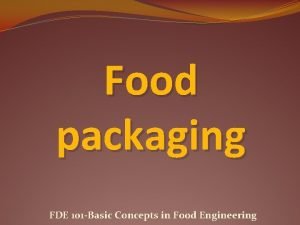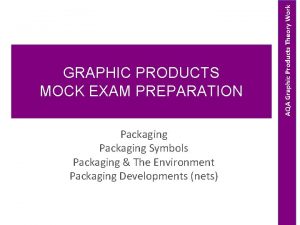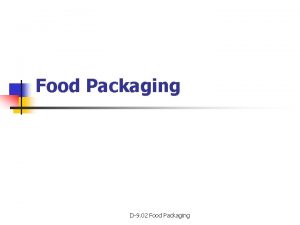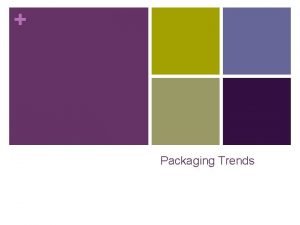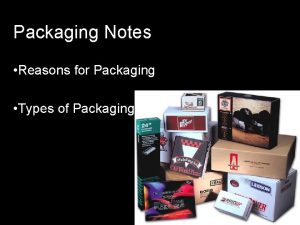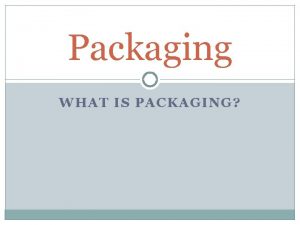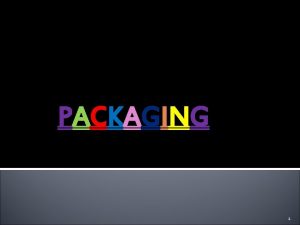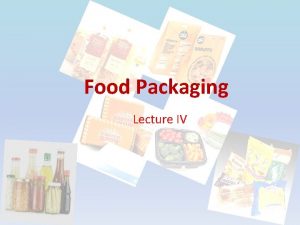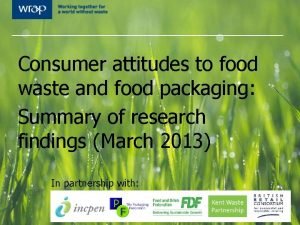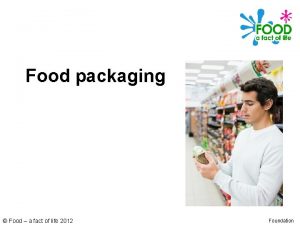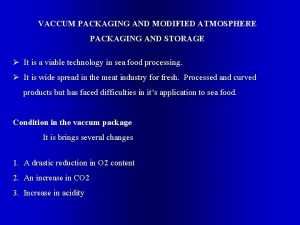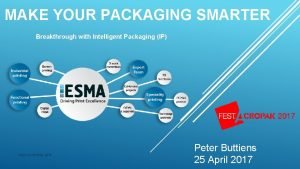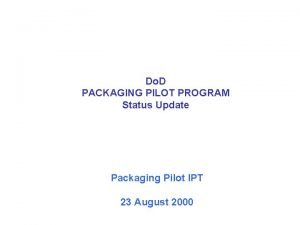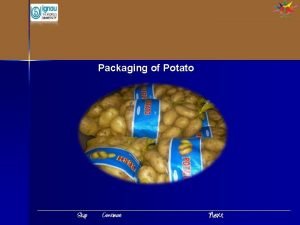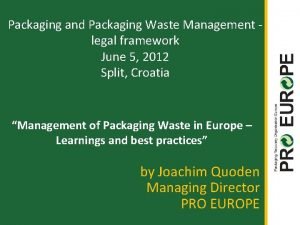Packaging the Environment Food packaging is known to

























- Slides: 25

Packaging & the Environment. Food packaging is known to cause a number of environmental issues because – • It uses up natural resources e. g. Oil, tress, metal etc. • It causes air, land or water pollution. • It cannot always be recycled and is not biodegradable. It has to be disposed of in landfill sites. Consumers can reduce waste by – • Recycling. • Re-using. • Choose things without lots of packaging. Manufactures can reduce waste by – • Reduce amount of packaging. • Use recyclable materials. • Print symbols to show it can recycled. • Making sure whole products can be recycled. • Using resources from sustainable forests. • To not stain or bleach wood.

ü Hermetically ü Airtight ü High-risk food ü Food which is an ideal medium for the growth of bacteria or micro-organisms ü Lecithin ü Present in egg yolk and soya and used as an emulsifier in manufactured foods ü Net weight ü Not including packaging ü Non starch polysaccharide ü The part of food that is not digested by the body ü Organoleptic ü Sensory qualities (texture, flavour, aroma, appearance) of a food product ü Prior knowledge ü Knowledge you already have which does not require research

There are three main types of fish: Ø Oily fish e. g. Herrings, mackerel, trout, sardines, salmon or tuna. Ø White fish – can be round (cod, haddock) flat (plaice, turbot, halibut, lemon sole. ) Ø Shellfish – can be crustaceans (crabs/lobsters, prawns, shrimps) or molluscs (oysters, scallops, cockles, muscles. )

Buying Fresh Fish. • Bright eyes indicate freshness and should be convex because it shows they haven’t lost water. • Bright red gills.

Buying Fresh Fish. Sea bass is an expensive, high quality fish. Mackerel is reasonably priced. Price of cod is going up.

Lobsters are expensive because of the way they are fished – bait in cage and one lobster usually caught per cage.

Buying Fresh Fish. • Farmed fish is when an area of the sea is cornered off purely to breed fish. • Mackerel should be firm to touch, is rich in omega 3 & 6 – is the best source. • Plaice should have vibrant orange spots.

ü Profiling test ü Sensory evaluation test to identify individual specific characteristics of products ü Prototype ü The first version of a product that is being developed ü Quality assurance ü A guarantee by retailers and manufacturers that products are safe and of a good quality ü Reference Nutrient Intake ü RNI: the amount of a nutrient that is enough for most people in a group ü Scaling up ü Multiplying up proportionally. Increasing a recipe for bulk production, keeping the ratio and proportions the same ü Stabilizers ü Substances which absorb water and are often used as thickening agents; many can produce gels and also act as emulsifiers ü Suspensions ü A solid held in a liquid ü Sustainability ü To continue to support ü Syneresis ü Usually refers to eggs; if overcooked, the proteins shrink as they coagulate and separate from the watery liquid

• Which are the two healthy fats contained in fish? ü Monounsaturated and polyunsaturated are the healthy fats in fish. Polyunsaturates, and to a lesser extent, monounsaturates, have been shown to lower blood cholesterol levels and therefore help in reducing the risk of heart disease.

• Explain the difference between HBV protein & LBV protein. ü HBV contains all of the essential amino acids and LBV is when there is a lack of one or more of the essential amino acids. High biological value protein contains all of the essential amino acids. It is found in meat, soy bean and quinoa. Low biological value is when there is a lack of one or more of the essential amino acids.

• Between what two temperatures do bacteria reproduce most quickly at? ü 5 -63°C. Bacteria grow at their very best at 37°C, however they reproduce quickly at any temperature between 5 -63°C.

• State two facts about Mackerel. ü If it’s fresh it should be firm to touch and it is rich in omega 3 & 6. If Mackerel is fresh it should be firm to touch. Mackerel is rich in omega 3 & 6.

ü Textured vegetable protein ü Protein produced from soya beans. It is either extruded or formed into chunks. Used as an alternative protein and as a meat extender ü Vacuum packaging ü A method of preserving food by removing air ü Consider ü Review and respond to given information ü Define ü Give the precise meaning of a word or phrase ü Discuss ü Investigate or examine through argument. Give reasons both for and against. Present salient points ü State ü Present in a concise and clear form ü Outline ü Explain the main features ü Illustrate ü Make explicit, present clarifying examples

Organic foods – processed organic foods use ingredients that were produced organically and organic ingredients must make up at least 95% of the food. Organic farming and food use a restricted use of artificial fertilisers or pesticides. Genetically Modified (GM) foods – involves altering a plant, animal or microorganism gene so they can grow faster/look more attractive/grow bigger. Free range foods – for example – chickens are able to roam free when being farmed instead of being in a cage.

Fairtrade – fairtrade is about better prices, decent working conditions, local sustainability and fair terms of trade for farmers and workers in the developing world. Farm assured – a product certification for agricultural products that emphasises the principles of quality assurance. Farm assurance schemes : organic certification, red tractor mark or freedom food. Sustainability – is about seeking ways of providing food, water and energy that are long-lasting and have less of an impact on the environment. Sustainability takes into account the process from field to plate, e. g. Transport.

HACCP stands for Hazard Analysis Critical Control Point. ü HACCP identifies critical points in a food process where hazards could arise and steps are put in place to prevent things going wrong. ü Some HACCP procedures: to train workers, check safety of food (dates, temperature etc. ) or random sample testing. ü There are biological, physical & chemical hazards. ü Hazards must be monitored and controlled by the manufacture, they can occur at any stage in food production: • Growing & harvesting raw ingredients. • Cooking. • Storage of the products by the manufacture. • Preparation of ingredients. • Cooling.

The Food Label Regulations, 1996 ü Why is this in place? Consumers should be confident with their choices of foods, be able to buy according to any particular requirements and be able to make comparisons with similar products. The Food Labelling Regulations 1996 This requires food to be marked or labelled with certain requirements such as: ü the name of the food ü a list of ingredients (including food allergens) ü the amount of an ingredient which is named or associated with the food ü an appropriate durability indication (e. g. ‘best before' or ‘use by') ü any special storage conditions or instructions for use ü the name and address of the manufacturer, packer or retailer ü the place of origin (where failure to do so might mislead)

ü What are carbohydrates split into? ü Starch and sugar. ü What does primary packaging do? ü Contains the food product. ü What does secondary packaging do? ü Holds several products together. ü What does transit packaging do? ü It is used when products are being transported to the point of sale. ü ____ is an expensive, high quality fish. ü Sea bass is an expensive, high quality fish. ü ____ is a reasonably priced fish. ü Mackerel is a reasonably priced fish. ü The price of ___ is going up. ü The price of cod is going up.

Storing and preparing fish. ü Fish is a moist protein food. It is HIGH RISK because it is prone to carrying bacteria. ü Fresh fish should be used as soon as possible or covered and stored in the fridge. ü Fillet should be moist or firm. How can you tell if a fish is fresh? Shouldn’t be flaky or dry. ü Eyes should be bright and glassy, shouldn’t be milky or creamy. ü Fresh fish shouldn’t smell very strong. ü Colour – should be nice and bright. A lot of fish is prepared and frozen at sea, so it remains in peak condition until it’s processed.

Storing and preparing fish. There are several ways to prepare fish: • You can eat hot smoked fish e. g. Mackerel and salmon without cooking it. • You need to cook cold smoked fish e. g. Haddock before you can eat it. • Oily fish and shellfish e. g. Tuna, salmon and prawns can be canned. They are normally canned in brine, tomato cause or oil. • Fish start to coagulate (set) at 60°C. So when frying, grilling, or baking fish you need enrobe it – this means to give it a protective coating like flour, breadcrumbs or batter. • You can steam or poach fish without a coating.

Ø What p. H do bacteria grow best at? Ø In a neutral p. H – between 6. 6 and 7. 5

Ø Oily fish is a good source of what vitamins? Ø Vitamins A and D, they are fat soluble vitamins.

Ø You can get a good source of which minerals, from shellfish? Ø Selenium, zinc, iodine and copper.

Ø Mussels, oysters, squid and crab are also good sources of. . . Ø Omega 3.

Ø How does modified atmosphere packaging delay bacteria growth? Ø By changing or modifying the air which surrounds the food.
 Brc standard 8
Brc standard 8 Packaging and packaging waste directive
Packaging and packaging waste directive Unit 2 food food food
Unit 2 food food food Grazing food chain diagram
Grazing food chain diagram Agent a chapter 2
Agent a chapter 2 Known vs unknown environment
Known vs unknown environment Environment of business finance
Environment of business finance What is food packaging in home economics
What is food packaging in home economics Objectives of food packaging
Objectives of food packaging Food packaging ads
Food packaging ads Function of food packaging
Function of food packaging Active packaging
Active packaging Hình ảnh bộ gõ cơ thể búng tay
Hình ảnh bộ gõ cơ thể búng tay Ng-html
Ng-html Bổ thể
Bổ thể Tỉ lệ cơ thể trẻ em
Tỉ lệ cơ thể trẻ em Gấu đi như thế nào
Gấu đi như thế nào Tư thế worm breton
Tư thế worm breton Hát lên người ơi
Hát lên người ơi Môn thể thao bắt đầu bằng chữ f
Môn thể thao bắt đầu bằng chữ f Thế nào là hệ số cao nhất
Thế nào là hệ số cao nhất Các châu lục và đại dương trên thế giới
Các châu lục và đại dương trên thế giới Cong thức tính động năng
Cong thức tính động năng Trời xanh đây là của chúng ta thể thơ
Trời xanh đây là của chúng ta thể thơ Mật thư anh em như thể tay chân
Mật thư anh em như thể tay chân Phép trừ bù
Phép trừ bù
